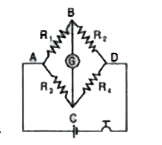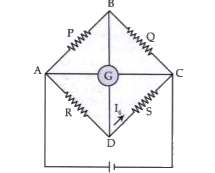Wheatstone's bridge is a very simple but powerfull concept which has made many calculations easy. If the assumption is made that current does not flow through the galvanometer from B to C or C to B,
VA−VB=VA−VD VB−VD=VC−VD

The current in R1, has to flow through BD and that in R3 through CD. This idea has been extended to many symmetrical circuits.
If R1=2 ohm, R3=4 ohm,R2=5 ohm, R4=10 ohm and iR1=1A, then the current in R3 is:
A
0.5 A
B
1.0 A
C
1.5 A
D
2.0 A
Text Solution
The correct Answer is:A
VA−VB=VA−VC
∴iR1×2Ω=iR3×4Ω∴iR3=0.5A
|
Topper's Solved these Questions
- CURRENT ELECTRICITYBOOK - MODERN PUBLICATIONCHAPTER - CURRENT ELECTRICITYEXERCISE - MULTIPLE CHOICE QUESTIONS ( LEVEL-II)
54 Videos
- CURRENT ELECTRICITYBOOK - MODERN PUBLICATIONCHAPTER - CURRENT ELECTRICITYEXERCISE - MULTIPLE CHOICE QUESTIONS (PARAGRAPH QUESTIONS)
2 Videos
- ATOMS, MOLECULES AND NUCLEIBOOK - MODERN PUBLICATIONCHAPTER - ATOMS, MOLECULES AND NUCLEIEXERCISE - Recent Competitive Questions
40 Videos
- DESCRIPTION OF MOTION IN ONE DIMENSION BOOK - MODERN PUBLICATIONCHAPTER - DESCRIPTION OF MOTION IN ONE DIMENSION EXERCISE - Revision Test
45 Videos
Similar Questions
Knowledge Check
Find the value of R for which no current will flow through 5V battery
 A4ΩB1ΩC3ΩD4Ω
A4ΩB1ΩC3ΩD4ΩAssertion (A): In balanced condition of a Wheatstone bridge, there is no current flow through the galvanometer.

Reason (R ): The potential of point B and D are same.ABoth A and R are true and R is the correct explanation of ABBoth A and R are true but R is NOT the correct explanation of ACA is true but R is falseDA is false and R is trueIn the R1=10Ω,R2=20Ω,R3=40ΩR4=80Ω and VA=5V,VB=10V,Vc=20V,VD=15V The current in the resistance R1 will be
 A0.4A toward OB0.4A away from OC0.8A toward OD0.8A toward O
A0.4A toward OB0.4A away from OC0.8A toward OD0.8A toward O
In the uniform electric field shown in figure, find :
a. VA−VD
b. VA−VC
c. VB−VD
d. VC−VD

View SolutionIf the above question, the potential has correct relations as given=
A. VA>VB>VC>VD
B. VA>VB≥VC>VD
C. VD=VC=VB=VA
D. VC<VB>VA>VD
View SolutionFind out following

(i) VA−VB (ii) VB−VC (iii) VC−VA (iv) VD−VC
(v) VA−VD (vi) Arrange the order of potential for points A, B, C and D.
View SolutionFind out following

(i) VA−VB (ii) VB−VC (iii) VC−VA (iv) VD−VC
(v) VA−VD (vi) Arrange the order of potential for points A, B, C and D.
View SolutionThe p.d (VB−VC between two point from C to B
View Solution
